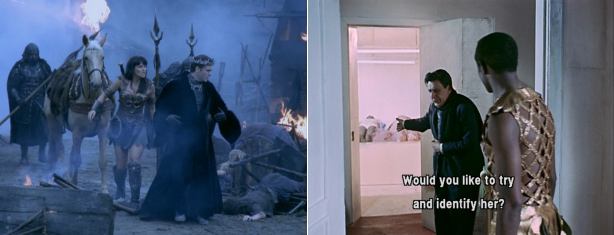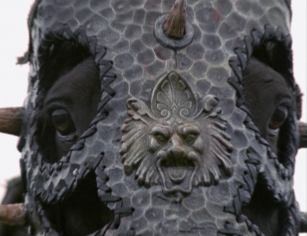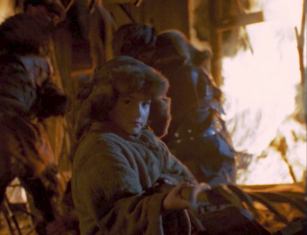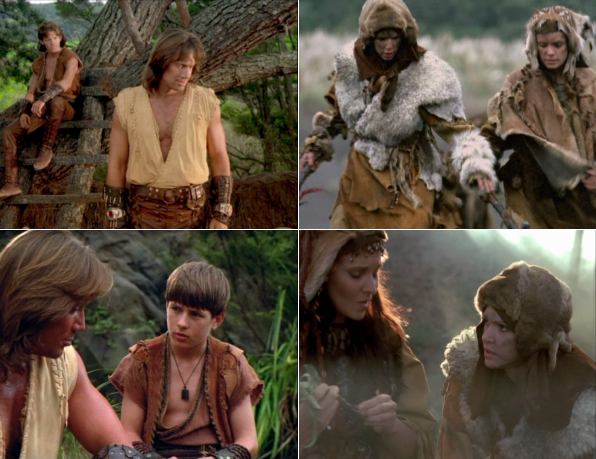| The fourth season of Xena has a long list of truth-telling villains; like the Stranger in The Bacchae, they all know their opponents' psychological weaknesses and how to exploit them. The season will end with Xena facing her chief villain, the dark, Dionysiac Julius Caesar. Adventures in the Sin Trade just happens to be positioned right at the midpoint of the series' six year run, a happy coincidence, since Mircea Eliade, the show's muse, is best known for his thesis that religion is a process of creating a center of the world to define one's existence, that ancient Thrace was the crossroads for the religions of the world, and the central religion that linked the ancient faiths was shamanism. This episode is worthy of that significance, as it manages to act as a crossroads for many of the series' motifs and themes. It's also the second of the three "Xena movies," directed by T.J. Scott, who also directed Girls Just Wanna Have Fun, and used the same techniques filming the ecstatic dances of the bacchae with the dance of ecstasy of the shamanesses here. All three of the "Xena movies" were written by Rob Tapert and RJ Stewart; the first, The Debt, was inspired by the Tao de Ching, and RJ Stewart's favorite philosopher, Schopenhauer. There's a little Schopenhauer here, too, but according to the dvd commentary, RJ says he knew little of shamanism, or had much interest in writing about it. That's as good a confirmation that we'll get that, unlike Robert Graves' The Greek Myths, which were required reading for everyone on the show, the works of Mircea Eliade served as a guide for Rob Tapert alone. Whenever the staff demurs to "Rob's vision" when faced with a question they can't answer, chances are that involves something borrowed from Eliade. It stands to reason, then, that anything on the show that appears to trace its lineage to Eliade may well mark the influence of Rob Tapert, and we can therefore get a better idea of not only who wrote what, but why. The four episode arc beginning with Adventures in the Sin Trade brings us back to the show's Orphic themes, borrowing heavily from Black Orpheus. Xena, having lost Gabrielle down a volcanic chasm, decides to search for her soul. This decision, and its dramatization, comes from Black Orpheus. After watching Eurydice die, Orpheus makes his way to the bureau of Missing Persons, where he finds stacks of paper and endless bureaucracy. He's directed by a janitor to seek her at a small Macumba church, where the dead are brought back to life through shamanic rituals. Macumba is related to Santeria and African rites, and we're also reminded of Altared States, which takes its title from a film about the quest for the soul's origin through South American hallucinogenic ritual. Orpheus finds himself in the middle of a Macumba rite, and calls for Eurydice among the women lost in the throes of ecstatic worship. Eurydice calls for him, channeled by an older woman who begs him not to look at her to prevent her return. He does, and Eurydice's voice is lost. Orpheus then goes back to the government building, to the city morgue, where another bureaucrat agrees to give him Eurydice's body: "Death is cheap here, right?"
We find another Orphic reference in the name of the Amazons' Queen. Rob Tapert has said that when they made Amazon High back during season three (assuming they weren't working on the concept as far back as season one, which may have been the case), they agreed that "Cyane" was a title for the Amazon Queen, going all the way back to their earliest tradition. Since "Amazon High" was about the founding of the Amazons, they used that opportunity to illustrate the rules that would govern future Amazon episodes, and sure enough, we see Cyane queens of the Northern Amazons all the way until the last Amazon episode in season six. The reason for this probably lies in both Graves and Eliade. In chapter 132, note s, we're told about the sacred chasm of Cyane, down which Hades took Persephone to the Underworld. We've already seen how this was probably referenced in Mortal Beloved, when Xena wept like Cyane by the lake entrance to Hades after her love descended to his fate in the afterlife. In Eliade we learn why Cyane is an appropriate name for an Amazon queen: water nymphs (such as Cyane) were numerous and ancient; they probably predated Greek myth, from matriarchal times. They were uncontrollable creatures of the water and wood, and their influence, for better or worse, was often on children. They would occasionally steal them, but they would also raise them to be heroes. As Eliade put it:
Throughout this episode we see flashbacks to Xena's betrayal of the Northern Amazons. She insinuates herself into their tribe as a potential recruit of great power, only to use their own strengths against them. She finds their hidden circle within the forest and annihilates their leadership. This scene reminds us of King Penthius's plot in The Bacchae: his wish to dress as them and spy on their ways to learn how to defeat them. When his mother discovers his spying, she calls out to her maenadic sisters: ""Maenads! Make a circle and take hold Of the trunk - let's capture this tree-climbing beast And stop him from revealing to anyone the secret dances of the god.'" This scene is inverted for this episode, with the secret council of the Northern Amazons breached by the spying Xena; they are unable to capture the tree-climbing Xena, who learned her skills from them, and the forest imagery of The Bacchae is employed in gruesome fashion to depict the slaughter of the tribal leaders. |
 The original clothes-swapping scene with Brigitte Lin in Dragon Inn, which ends with a familiar-looking costume (see: Cyane). |





